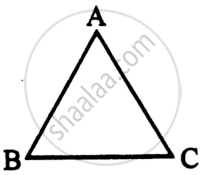Advertisements
Advertisements
Question
The work function for a metal surface is 2.2eV. If the light of wavelength 5000Å is incident on the surface of the metal, find the threshold frequency and incident frequency. Will there be an emission of photoelectrons or not? (c = 3 x 108 m/ s, 1eV = 1.6x10-19 J , h = 6.63 x 10-34 J.s.)
Solution
Given work function = `Φ_0` = 2.2 eV
= `2.2 xx 1.6 xx 10^(-19) J`
= `3.52 xx 10^(-19)`
λ = 500 Å = 5000 x 10-10 m, c = `3xx10^8` m/s, h = `6.63 xx 10^(-34) Js`
Incident frequency v = `c/λ = (3xx10^8)/(5000 xx 10^(-10)`
= `(3xx10^8)/(5xx10^(-7) )= 3/5 xx 10^(-15) Hz`
=`30/5 xx 10^(14) Hz = 6 xx 10^(14) Hz`
Threshold frequency v0 = `Φ_0/h = (3.52 xx 10^(-19) J)/(6.63 xx 10^(-34) Js`
= `0.53 xx 10^15 Hz = 5.3 xx 10^14 Hz`
Emission of photoelectron takes place only if incident frequency is greater than the threshold frequency. But, in this case n>n0 therfore, photoelectric emission takes place.
APPEARS IN
RELATED QUESTIONS
The energy of photon of wavelength X is_____ .
[h = Planck’s constant, c = speed of light in vacuum]
State two important properties of photon which are used to write Einstein’s photoelectric equation.
Define (i) stopping potential and (ii) threshold frequency, using Einstein’s equation and drawing necessary plot between relevant quantities.
A proton and a deuteron are accelerated through the same accelerating potential. Which one of the two has less momentum?
Give reasons to justify your answer.
Write its S.I. unit of (intensity of radiation)
Radiation of frequency 1015 Hz is incident on two photosensitive surface P and Q. There is no photoemission from surface P. Photoemission occurs from surface Q but photoelectrons have zero kinetic energy. Explain these observations and find the value of work function for surface Q.
With reference to the photoelectric effect, define threshold wavelength
Write Einstein’s photoelectric equation.
According to Einstein’s model minimum energy needed for the electron to escape from a metal surface having work function ϕ0, the electron is emitted with maximum kinetic energy, Kmax = ______.
According to the Einstein’s model, stopping potential Vo for a metal having work function ϕ0 is given by ______.
A police van moving on a highway with a speed of 30 km/h fires a bullet at a thief's car speeding away in the same direction with a speed of 192 km/h. If the muzzle speed of the bullet is 150 m is, with what speed does the bullet hit the thief's car?
In an inelastic collision, which of the following does not remain conserved?
Radiations of two photon's energy, twice and ten times the work function of metal are incident on the metal surface successively. The ratio of maximum velocities of photoelectrons emitted in two cases is:
A 200 W sodium street lamp emits yellow light of wavelength 0.6 µm. Assuming it to be 25% efficient in converting electrical energy to light, the number of photons of yellow light it emits per second is:
Threshold frequency for photoelectric effect on sodium corresponds to a wave length 5000. Its work function is ______.
Einstein work on the photoelectric effect provided support for the eqn:-
Who indirectly determined the mass of the electron by measuring the charge of the electrons?
If the frequency of light in a photoelectric experiment is double the stopping potential will
The slope of frequency of incident light and stopping potential for a given surface will be
The wavelength of matter is independent of
(i) A ray of light incident on face AB of an equilateral glass prism, shows minimum deviation of 30°. Calculate the speed of light through the prism.

(ii) Find the angle of incidence at face AB so that the emergent ray grazes along the face AC.
How does stopping potential in photoelectric emission vary if the frequency of incident radiation decreases?
